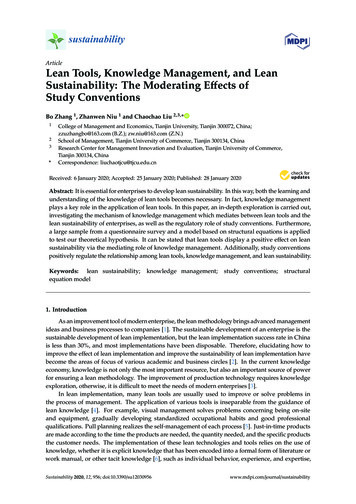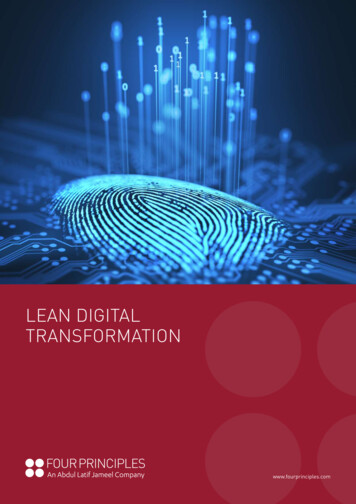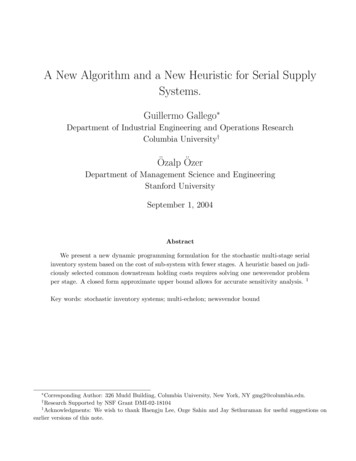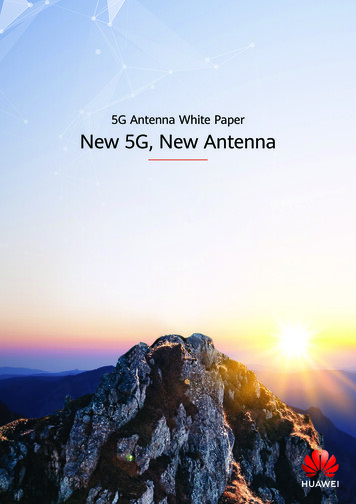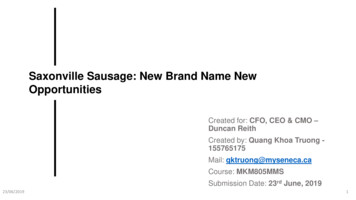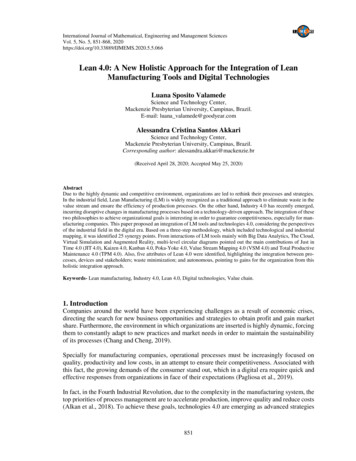
Transcription
International Journal of Mathematical, Engineering and Management SciencesVol. 5, No. 5, 851-868, an 4.0: A New Holistic Approach for the Integration of LeanManufacturing Tools and Digital TechnologiesLuana Sposito ValamedeScience and Technology Center,Mackenzie Presbyterian University, Campinas, Brazil.E-mail: luana valamede@goodyear.comAlessandra Cristina Santos AkkariScience and Technology Center,Mackenzie Presbyterian University, Campinas, Brazil.Corresponding author: alessandra.akkari@mackenzie.br(Received April 28, 2020; Accepted May 25, 2020)AbstractDue to the highly dynamic and competitive environment, organizations are led to rethink their processes and strategies.In the industrial field, Lean Manufacturing (LM) is widely recognized as a traditional approach to eliminate waste in thevalue stream and ensure the efficiency of production processes. On the other hand, Industry 4.0 has recently emerged,incurring disruptive changes in manufacturing processes based on a technology-driven approach. The integration of thesetwo philosophies to achieve organizational goals is interesting in order to guarantee competitiveness, especially for manufacturing companies. This paper proposed an integration of LM tools and technologies 4.0, considering the perspectivesof the industrial field in the digital era. Based on a three-step methodology, which included technological and industrialmapping, it was identified 25 synergy points. From interactions of LM tools mainly with Big Data Analytics, The Cloud,Virtual Simulation and Augmented Reality, multi-level circular diagrams pointed out the main contributions of Just inTime 4.0 (JIT 4.0), Kaizen 4.0, Kanban 4.0, Poka-Yoke 4.0, Value Stream Mapping 4.0 (VSM 4.0) and Total ProductiveMaintenance 4.0 (TPM 4.0). Also, five attributes of Lean 4.0 were identified, highlighting the integration between processes, devices and stakeholders; waste minimization; and autonomous, pointing to gains for the organization from thisholistic integration approach.Keywords- Lean manufacturing, Industry 4.0, Lean 4.0, Digital technologies, Value chain.1. IntroductionCompanies around the world have been experiencing challenges as a result of economic crises,directing the search for new business opportunities and strategies to obtain profit and gain marketshare. Furthermore, the environment in which organizations are inserted is highly dynamic, forcingthem to constantly adapt to new practices and market needs in order to maintain the sustainabilityof its processes (Chang and Cheng, 2019).Specially for manufacturing companies, operational processes must be increasingly focused onquality, productivity and low costs, in an attempt to ensure their competitiveness. Associated withthis fact, the growing demands of the consumer stand out, which in a digital era require quick andeffective responses from organizations in face of their expectations (Pagliosa et al., 2019).In fact, in the Fourth Industrial Revolution, due to the complexity in the manufacturing system, thetop priorities of process management are to accelerate production, improve quality and reduce costs(Alkan et al., 2018). To achieve these goals, technologies 4.0 are emerging as advanced strategies851
International Journal of Mathematical, Engineering and Management SciencesVol. 5, No. 5, 851-868, 2020https://doi.org/10.33889/IJMEMS.2020.5.5.066to drive improved process efficiencies while reducing operating costs and maintaining global quality standards (Rüßmann et al., 2015; Schmidt et al., 2015). However, it is noteworthy that Industry4.0 has often been presented as the solution that will, by itself, ensure the productive sector successin the digital era, leaving a gap on the efforts to improve the organizational processes used untilthen, such as those associated with Lean Manufacturing (LM) (Alkan et al., 2018; Dombrowski etal., 2017; Wagner et al., 2017).LM is considered a management philosophy developed in the beginning of the Third IndustrialRevolution and has been implemented and adapted in different sectors of industries, incurring inincreasing the organization's efficiency (Tayaksi et al., 2020). Due to fixed manufacturing sequences and slow responsiveness, associated with increasing pressures from customer expectationsregarding product variability, LM may not meet the new needs imposed by the digital technologyapplied in industrial field, and its suitability for future value chains can be limited (Ma et al., 2017;Mayr et al., 2018). From this perspective, the question arises whether the principles disseminatedby LM can be applied in harmony with advanced manufacturing.In this context, it is highlighting the LM difficulties of make industrial processes more flexiblewhen they are faced with product mix, rapid demand variations or low volume production. Thesesituations are linked to the production personification according to requirements of each consumer,considering one of the points defended in the industry-customer relationship in the digital age. Thenew manufacturing context may require the introduction of new machines and a new productionflow balance, as well as the need for stock to stabilize an interrupted flow (Alkan et al., 2018;Čiarnienė and Vienažindienė, 2012).Since these two approaches are fundamentally different, as Industry 4.0 has begun to move forwardin production with autonomous and flexible systems based on a technology-driven approach, whileLM keeps traditional processes focused on efficiency, this paper proposes a holistic integration ofLM tools and technologies 4.0, considering the perspectives of the industrial environment in thedigital era. The design of a holistic integration offers a way to companies to identify the importanceand the relationships between LM and Industry 4.0, pointing out the convergences and the organizational gains from the interaction between the Just in Time (JIT), Kanban, Poka-Yoke, ValueStream Mapping (VSM), Kaizen and Toyota Productive Maintenance (TPM) with digital technologies. This integration proposal means the alignment of a lean production system according to thetechnological trends arising from Industry 4.0, demonstrating that the organizational goals can beachieved jointly by these two approaches. Therefore, this study contributes to the industrial fieldthrough the exploration of two philosophies that, when applied together, can optimize companyindicators, pointing out a practical path to be followed by lean companies from different sectorsthat are looking to adapt to the Fourth Industrial Revolution.2. Literature Review2.1 Lean ManufacturingThe concept of Lean Manufacturing (LM) was originated at Toyota Motor Corporation, a Japaneseautomotive manufacturer. To ensure the company's development and survival, Taiichi Ohno, Toyota's chief engineer, introduced the Toyota Production System (TPS) in 1988, a business strategyfocused on working with the limited resources available in Japan (Behrouzi and Wong, 2011). Incontrast to the U.S. manufacturing model, which is operated with many different machines and hada large amount of intermediate products, the LM is focused on elimination of any type of waste,852
International Journal of Mathematical, Engineering and Management SciencesVol. 5, No. 5, 851-868, ming to supply the exact quantity of products required by customers, in the right time and withthe high quality (Tayaksi et al., 2020).Womack et al. (1990) define the LM production logic as a dynamic process based on principlesand practices, which are aimed to achieve the continuous improvement through elimination ofwaste. Being applicable across variables business domains, LM provides multidisciplinary management practices which integrates quality processes, work teams, and customer and supplier networks (Mrugalska and Wyrwicka, 2017; Womack et al., 1990).For LM implementation in the organizational context, it is necessary to use the LM tools, as wellas the joint action and motivation of all employees of the company. In this article, there will bedetailed the LM tools JIT, Kanban, Poka-Yoke, VSM, Kaizen and TPM, as descripted accordingto Table 1.Table 1. The main LM tools applied in the productive contextLM TOOLJITKanbanPoka-YokeVSMKaizenTPMDESCRIPTIONBeing on of TPS pillars, JIT aims to produce only the essentials at the time, date and quantity required. Unliketraditional processes, it pulls production along the supply chain, processing materials only if the next operation requires them. From the perspective of system-wide dependency, JIT enables advantages in order to reduce problemswith overproduction, transport, lead time, excessive resource movement and product defect (Mayr et al., 2018;Sanders et al., 2016).Kanban system can reach a minimum stock at any time. This tool makes the processes and materials flow throughthe cards which represent a sequence of orders and resources on the shop floor, while record the main information ofthe efficient production flow (Kolberg and Zühlke, 2015).Devices that prevent and detect losses from any source, being able to automatically cease the production line whenneeded. They stand out for their simplicity of operation and their intuitive design features. These devices help toreduce variability and maintain stability and control of production processes (Mrugalska and Wyrwicka, 2017; Zhang,2014).The value stream consists of all actions currently required in the production line, covering the value added as well asthe non-aggregating ones. The visual representation of this flow enables a systematic process analyze which permeates various levels of a production structure. This analyze is used in order to eliminate waste, streamline work tasks,reduce lead time and costs, and increase productivity quality (Wagner et al., 2017).Kaizen philosophy promotes improvements as a result of continuous effort and the kaizen events are often associatedwith waste reduction techniques, lead time and workstation balancing (Knechtges and Decker, 2014).This concept aims to improve productivity and quality, as well as motivating employees and contributing to jobsatisfaction. It has an innovative maintenance approach that optimizes equipment effectiveness, eliminates failuresand promotes unattended operator maintenance through daily activities which involves the workforce (Mayr et al.,2018; Singh et al., 2013).2.2 Industry 4.0Industrial revolutions are historically associated with disruption in production models. It beganwith the emergence of steam engines, advancing to the use of electricity and culminating in theDigital Revolution, which introduced the application of computer innovations in manufacturingcontext. The rapid pace of technological development is changing how the society works and relatesto the environment (Eliasen et al., 2018).Nowadays, the Fourth Industrial Revolution aims to achieve faster innovation in manufacturingprocesses with greater value chain efficiency (Ben-Daya et al., 2019). Focusing on processes flowautomation, Industry 4.0 enables flexibility and customization of products and services and, consequently, it increases the profitability maximization (Schmidt et al., 2015).853
International Journal of Mathematical, Engineering and Management SciencesVol. 5, No. 5, 851-868, dustry 4.0 could be considered a new production stand, once it aims to develop a smart and openmanufacturing platform for the data application an industrial network. Converting common machines into self-conscious and self-learning equipment to improve their overall performance andmanagement, smart factories will be able to monitor real-time data, track product status and positions, and maintain instructions for controlling the production processes (Javaid and Haleem, 2019;Vaidya et al., 2018).The digital revolution will impact in a complex way on production systems, providing solutionsthrough the technologies 4.0 combinations. These associations lead organizations to rethink thevalue chain of their new products and how to develop them to insert on market. In this article, themost cited technologies 4.0 in the literature were studied, including Big Data Analytics, AutomatedGuided Vehicles (AGVs), Virtual Simulation (VS), Cybersecurity, Cloud Computing (The Cloud),Additive Manufacturing (AM) and Augmented Reality (AR) (Kolberg and Zühlke, 2015; Mayr etal., 2018; Pereira et al., 2019; Sanders et al., 2016).Big Data Analytics refers to a large amount of varied data, which is processed into informationwith high capture speed and greater visibility, improving the efficiency and effective-ness of organizations in decision making processes (Vaidya et al., 2018).In Industry 4.0 context, robots that are autonomous, flexible, cooperative and with many skillsconceptualize AGVs. They are able to operate in the real world without any external control forlong periods of time. Also, without the need to isolate their work area, and human can work togetherwhich makes processes more productive and economical (Mayr et al., 2018).VS is a computational system-based modeling which fosters real-time data to mirror the physicalworld into a virtual model that includes machines, products, and humans. This simulation providesa prior analysis of all the steps that make up the process, presenting performance estimates forproduction indicators (Bahrin et al., 2016).Cybersecurity technology aims to protect programs, computers, networks and data, ensuring security the security and reliability of communications and the management of resources and information. Smart factories will work with standard communication protocols and high connectivityamong all links of value chain (Rüßmann et al., 2015; Ustundag and Cevikcan, 2018).The Cloud provides unified communication between the technology level (smart products andcyber-physical systems) and the highest hierarchy level in an organization. Innovation that increases data sharing across enterprise boundaries, improves system performance, makes it moreagile and flexible, and reduces costs (Ma et al., 2017; Vaidya et al., 2018).AM refers to a set of computer-automated processes that construct products layer by layer, basedon three-dimensional models designed in Computer-Aided Design software. This approach permitsfor an object being produced in one step or with a reduction in the number of steps, as well asprovides easily customized products (Bahrin et al., 2016).Finally, AR technology works with overlapping virtual objects with the existing environment. InAR displays, virtual and real information, previously acquired with a camera, are digitally mergedand represented on a screen, creating an interface between employees and digital products or equipment (Mayr et al., 2018; Rüßmann et al., 2015).854
International Journal of Mathematical, Engineering and Management SciencesVol. 5, No. 5, 851-868, 2020https://doi.org/10.33889/IJMEMS.2020.5.5.0663. MethodologyThe present work can be considered an exploratory and descriptive study, based on a three-stepmethodology (Figure 1), including observation, categorization and association macro phases(Prasetyo and Arman, 2017).The first step performed a bibliographic research to standardize information about the technologies,principles and attributes of Industry 4.0 and LM. The categorization elaborated the review structure,which analyzed each of the LM tools, as well as the technologies 4.0, for development of technological and industrial mappings. The association consisted in a relationship matrix between technologies 4.0 and LM tools, as well as six multi-level circular diagrams to illustrate the synergypoints between these two concepts. Literature ReviewOBSERVATION Information Standardization Technological MappingCATEGORIZATION Industrial Mapping Relationship MatrixASSOCIATION Multidimensional DiagramsFigure 1. Research methodology stages applied in this studyIn the first step, a literature review was performed to identify the principles, attributes and guidingconcepts of LM and Industry 4.0. The databases Web of Science, ScienceDirect, Scopus and IEEEXplore were used; main fields of research included Lean Manufacturing, Toyota Production System, Lean Thinking, Lean Methodologies and Tools, Industry 4.0, Cyberphysical System, Emerging Technologies, Attributes 4.0, and Intelligent Factories. Inclusion and exclusion criteria of articles, data definition to be selected from articles, analysis, discussion and results presentation wereconsidered as steps of the literature review.An industrial mapping was developed in the categorization step and LM was evaluated in relationto its implementation model, attributes, tools and practices applied in the production context. Asthe first topic addressed, the history of the LM concept was searched, focusing on its emergence855
International Journal of Mathematical, Engineering and Management SciencesVol. 5, No. 5, 851-868, d characteristics which constitute the TPS. Once the importance of the LM approach in production systems has been explained, the following LM-focused tools were studied and detailed. EachLM tool was described according to LM philosophy, considering JIT, Kanban, Poka-Yoke, VSM,Kaizen and TPM.Also, the data standardization about Industry 4.0 was developed considering the current status ofthe Fourth Industrial Revolution, from the technological perspective. This paper developed an analysis of Industry 4.0 from the point of view of systems, processes and technology, in order to allowa micro view of this new approach and to glimpse how these elements are configured in the productive chain. Therefore, for Industry 4.0 technology mapping, the main technologies were identified, consisting of Big Data Analytics, AGVs, VS, Cybersecurity, The Cloud, AM and AR. Thecharacterization of each technology was performed, considering the principles and characteristicsof implementation.Finally, in the association step, the relationship matrix was developed to evaluate the potential ofintegration between LM and Industry 4.0, covering the analysis of how the impacts of technologies4.0 can influence the LM-focused tools. Synergy points indicated in the matrix was also representedby a multi-level circular diagrams, covering each LM tool, the adherent technologies 4.0 and, theattributes of this interaction (Figure 2), pointing out the main contributions of JIT 4.0, Kaizen 4.0,Kanban 4.0, Poka-Yoke 4.0, VSM 4.0, TPM 4.0.Figure 2. Attributes of LM and Industry 4.0 integrationAttributes of the Lean 4.0 was classified in five dimensions presented on Figure 2, consisting in (i)integration among processes, devices and stakeholders; (ii) minimization and/or elimination ofwastes; (iii) supply chain flexibility; (iv) autonomation; (v) and analytics solutions to provide continuous flow. These categories represented the main attributes resulted from the integration betweenLM and Industry 4.0, considered, in this paper, the contributions of this relationship to organizationenvironment.4. Results and DiscussionAccording to Table 2, it is noteworthy that for each technology 4.0 addressed in this study, at leasttwo relationships with LM tools were identified, resulting in 25 synergy points. Big Data Analytics(5), The Cloud (5), AGVs (4), VS (4) and AR (4) presented the highest number of relationships856
International Journal of Mathematical, Engineering and Management SciencesVol. 5, No. 5, 851-868, th lean philosophy. TPM was the tool that showed the greatest potential for convergence withdigital technologies, totaling six points of interaction.Each relationship between the two approaches was explained followed by its respective multi-levelcircular diagram. Therefore, LM tools, the adherent technologies 4.0 and, then, the attributes of thisinteraction resulted in a total of 68 points of contribution among the six diagrams, encompassingintegration among processes, devices and stakeholders (16); minimization and/or elimination ofwastes (16); supply chain flexibility (10); autonomation (16); and analytics solutions to providecontinuous flow (10).Table 2. Conceptual combination among LM tools and technologies 4.0TECHNOLOGIES 4.0LM TOOLJITKanbanPoka-YokeVSMKaizenTPMBig DataAnalyticsXXXXXAGVsAMThe CloudXXXXXXCybersecurityVSARXXXXXXXXXXXXXX4.1 Just-In-Time 4.0Considered one of the pillars of the TPS, JIT aims to produce the product in the right quantity, time,quality, location and manufacturing costs, without the need to develop a product inventory. However, in current logistics system, JIT objectives are not always fulfilled due to incomplete productsstatus, incompatibility between required and transported products, and unexpected delays duringtransportation processes (Mayr et al., 2018; Sanders et al., 2016).According to Figure 3, technologies 4.0 can contribute to more efficiently achieve the goals of thisapproach, including the application of The Cloud, Big Data Analytics, AGVs, AM and AR. Theuse of these technologies provides four attributes resulted from LM and Industry 4.0 relationship,principally the supply chain flexibility and integration among processes, devices and stakeholders.These tools, when put into practice in the production environment, provide a continuous, transparent, automated, and customer-driven product and information flow.Receiving real-time supply chain data from several devices, sensors, computers and AGVs, TheCloud is able to share them with Big Data Analytics, which interprets and transforms these data ininformation for stakeholders to provide a better management. The Cloud is also connected with allemployees from shop floor, sending data and interpreted information to their visual field throughAR device, help them to solve issues and take better decisions quickly. Also, the exact personalcustomer request can be prepared by AM technologies, using less raw materials and process time,once this innovation produces only the quantity required with flexibility by adding material layers.In fact, Sanders et al. (2016) state that The Cloud technology, when implemented in Internet ofThings (IoT), has different integrated communication devices that manage information about transported products. Once each product has wireless tracking of its origin, destination, and current857
International Journal of Mathematical, Engineering and Management SciencesVol. 5, No. 5, 851-868, atus, this technology 4.0 enables on-time delivery of items as well as optimizes transportationroutes and logistics reliability, which adds value to customers.As well as The Cloud, AGVs have made logistics automated, adjusting it in real-time according toproduction line needs. In accordance to Mayr et al. (2018), AGVs can carry objects within thematerial flow automatically, which minimizes human error as well as unnecessary travels.Also included in IoT, Big Data Analysis techniques support JIT. Using this technology 4.0, it ispossible to interpret detailed data of the production processes in real time, helping to identify trendsand to derive rules for the system, which contributes to better performance of entire supply chain(Sanders et al., 2016).Figure 3. Just in Time 4.0: correlation between the JIT method with technologies 4.0It is also emphasized that, according to Kolberg and Zuhlke (2015), AR displays cooperate to createa continuous production flow, which assists production line employees. Thus, cycle times information provided in the workers' visual field contributes for JIT system.Frazier (2014) relates JIT with AM technologies, which favors small batch production. In this typeof production, the high costs arising from the specific raw materials required are offset by the fixedcosts reduction of conventional subtractive manufacturing methods. This advantage, combinedwith AM characteristics such as speed, versatility and adaptability, allow JIT production.858
International Journal of Mathematical, Engineering and Management SciencesVol. 5, No. 5, 851-868, 2 Kanban 4.0Kanban is a tool for implementing customer pull production and promotes a continuous materialflow with waste-free processes, while maintaining a pre-defined inventory level to ensure uninterrupted material supply. It is noted that the inadequate monitoring of materials quantity supplied toproduction line, as well as changes in the production schedule, could severely alter this pull system(Mayr et al., 2018; Sanders et al., 2016).In traditional LM flow, changes in production processes, regulatory stocks, or cycle times requiredcomplicated adjustments to Kanban cards. These variations limited the LM adequacy for individualand customized products or products with shorter life cycles (Kolberg and Zühlke, 2015).However, in the context of Industry 4.0, new solutions are available to be incorporated into Kanbansystems, such as Big Data Analytics, AGVs, and VS, which are synthesized in Figure 4. Four Lean4.0 attributes are afforded, which two of them are highlighted with three designation points, beingthe integration among processes, devices and stakeholders, and the minimization and/or eliminationof wastes. Applying these technologies, intermediate material stocks can be reduced to a minimum,as Big Data Analytics contributes to production flow real-time monitoring, which provides automated logistics with intelligent inventory control.Figure 4. Kanban 4.0: correlation between the Kanban tool with technologies 4.0The constant transformation of data into information from the entire production flow is essential tocreate new Kanban systems, designed through VS technologies. This technology 4.0 is able to present multiple perspectives of productive contexts, which anticipates solutions and predicts the production behavior to reduce bottlenecks. AGVs, in turn, replenish work stations according to real859
International Journal of Mathematical, Engineering and Management SciencesVol. 5, No. 5, 851-868, d exact needs of the production line, reducing inventories, lead times and unnecessary movements.In fact, combining the Kanban with technologies, an e-Kanban system can be developed to replaceconventional physical cards. This virtual Kanban is able to recognize empty box to trigger automatic replenishment, to control the level of material batches loading and to monitor the productionschedule changes (Sanders et al., 2016).Acting in conjunction with other technologies, Big Data Analytics constantly tracks workflow inprogress, once it receives data from multiple factory sources. Then, this technology 4.0 increasesthe transparency of material and process movements, and enables the combination of target andactual values to remove unnecessary stock.The AGVs are another innovation raised by Mayr et al. (2018), which further contribute to materialreduction. These vehicles replenish production lines at the exact moment when more material isneeded, reducing the need to fill multiple stock points with the same feature.Using software of VS, new Kanban projects can be planned in real time, resulting in a broader andmore integrated view of the production flow. Through simulations, optimal parameters for this LMtool can be automatically identified and updated, such as lot size, inventory, and delivery frequency(Kolberg and Zühlke, 2015).4.3 Poka-Yoke 4.0The Poka-Yoke mechanisms promote detection and elimination of abnormal conditions in production processes to prevent defective products creation. This LM tool generates forced sequences inthe production lines and reviews the processes during their execution, stopping them in cases oferrors and issues founded (Zhang, 2014).According to Figure 5, AGVs, The Cloud, Cybersecurity and AR technologies 4.0 have relationships with this Lean tool. It s also noted that Poka-Yoke 4.0 presented all of the main attributesfrom LM and Industry 4.0 association, among which stands out the benefit of minimization and/orelimination of wastes, with four contribution points. Since the logic of Poka-Yoke is to preventerrors in production systems, AGVs are able to quickly adapt to possible flow failures and informThe Cloud about the problems encountered for later analysis and resolution. AR, in turn, workstogether with employees, helping them in their manual tasks to avoid possible slips, as well aspresenting instructions and virtual elements in their displays that facilitate the understanding andperformance of activities.In order to maintain a flawless environment, Poka-Yoke directly contributes to improving the security of productive operations, working side by side with cybersecurity systems.Mayr et. al. (2018) identified the benefits of AGVs in production chains. These devices are capableto act together with the employees and to adjust automatically in various line functions consideringpossible irregularities, ensuring the total quality of the manufactured product.Mrugalska and Wyrwicka (2017) also demonstrated that using actuators, sensors and wirelessvideo, the flow robots and machines collect data from the production line. These data are analyzed860
International Journal of Mathematical, Engineering and Management SciencesVol. 5, No. 5, 851-868, d pursued in The Cloud to provide a better operational intelligence, as well as to avoid possibleproduction errors, which relates with the central idea of Poka-Yoke tool.Offering significant advantages such as speed, reliability, and reduced failure rate, AR technologysupports the worker in real time during manual operations, assisting to reduce human errors. Presenting intuitive information in its displays combined with collab
Lean 4.0: A New Holistic Approach for the Integration of Lean . This integration proposal means the alignment of a lean production system according to the . and promotes unattended operator maintenance throu



